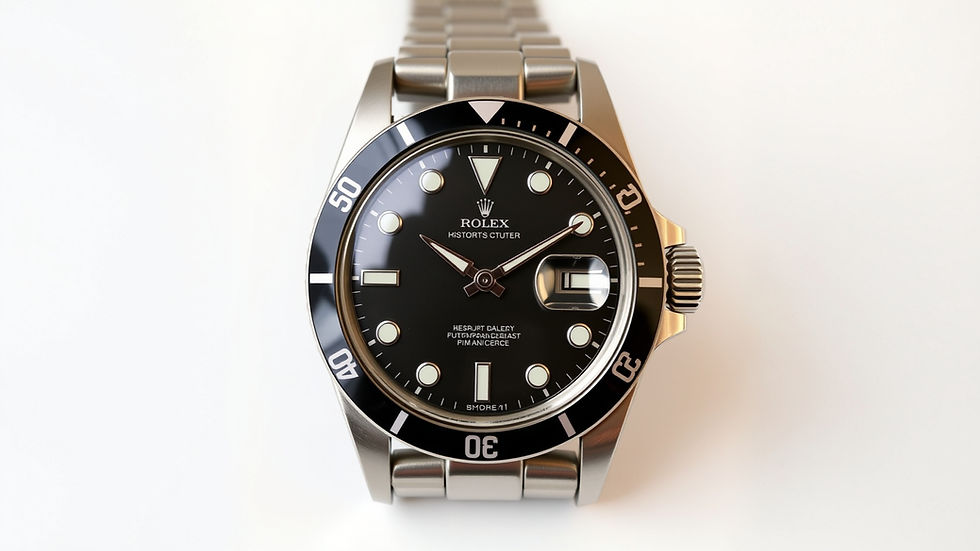The History of Rolex Watches for Men: How Precision Became Prestige
- Eva Wilson
- Oct 26
- 3 min read
When you hear the word “Rolex,” it conjures an immediate image: a symbol of success, uncompromising quality, and enduring prestige. Yet, the legendary status of Rolex watches for men didn't start with luxury; it began with an almost fanatical dedication to precision and utility. The journey from a reliable time-telling instrument to the world’s most coveted status symbol is a fascinating tale of innovation, exploration, and marketing genius.

The Bold Beginning: Precision on the Wrist
The story of Rolex begins in 1905 with its founder, Hans Wilsdorf, a visionary who foresaw the wristwatch overtaking the pocket watch. At the time, wristwatches were considered delicate, feminine accessories. Wilsdorf's bold ambition was to create robust, accurate wristwatches that men could truly depend on. This quest for precision was not just a marketing ploy; it was the foundation of the brand.
In an era when accuracy was primarily reserved for large, stationary marine chronometers, Wilsdorf sent his compact movements for certification. The pivotal moment came in 1910 when a Rolex was awarded the first-ever Swiss Certificate of Chronometric Precision for a wristwatch. Four years later, the Kew Observatory in England granted a Rolex a Class A certificate, a distinction previously reserved only for the most accurate naval timepieces. These early, objective validations cemented the brand’s reputation for technical excellence, paving the way for the sophisticated and reliable Rolex watches for men we know today.
The Era of the Oyster and Perpetual Motion
Rolex’s reputation transcended mere accuracy with the introduction of two groundbreaking innovations that revolutionised watchmaking:
The Oyster Case (1926): This was the world's first truly waterproof and dustproof wristwatch. Wilsdorf’s genius was in creating a hermetically sealed case with a screw-down bezel, caseback, and winding crown, protecting the movement within. To prove its durability, he had a watch strapped to the wrist of swimmer Mercedes Gleitze during her English Channel crossing in 1927. The watch emerged in perfect working order, instantly establishing the Rolex Oyster as a reliable tool for any environment.
The Perpetual Movement (1931): Rolex introduced the self-winding mechanism featuring a Perpetual rotor. This rotor wound the mainspring with the natural movement of the wearer's wrist, eliminating the need for manual winding. It merged convenience with constant, reliable power, another massive leap in making Rolex watches for men the ultimate daily wear timepiece.
The Birth of Icons: Tool Watches for Professionals
The mid-20th century saw Rolex pivot from general innovation to creating purpose-built timepieces that became icons of their respective fields. This focus on "tool watches" cemented the brand's place as a companion for modern exploration and professional pursuit:
The Submariner (1953): One of the most famous Rolex watches for men, the Submariner was designed for professional divers. It featured a rotating bezel to track immersion time and a remarkable water resistance for the era. Its rugged functionality and clean design made it a legend, equally at home under the sea or on the silver screen (famously worn by James Bond).
The GMT-Master (1955): Developed in collaboration with Pan American World Airways (Pan Am) for its pilots, the GMT-Master allowed the wearer to simultaneously track two different time zones. Its distinctive two-tone bezel, which gave rise to legendary nicknames like "Pepsi" and "Root Beer," turned a technical requirement into a design masterpiece for the jet-set era.
The Cosmograph Daytona (1963): Built for racing drivers, this chronograph became synonymous with the world of motorsports. Its precise timing function and tachymetric scale captured the spirit of speed, elevated further by its association with actor and racing enthusiast Paul Newman.
The Day-Date (1956): Known universally as "The President's Watch" due to its association with global leaders, the Day-Date was the first watch to display the day of the week spelled out in full alongside the date. Exclusively crafted in precious metals, this model became the ultimate symbol of achievement, power, and prestige among Rolex watches for men.
A Legacy Beyond Timekeeping
Today, owning a Rolex is an acknowledgment of a legacy built on over a century of genuine innovation. The crown logo is instantly recognisable worldwide, signifying not just a luxury purchase, but an investment in an object whose value is inextricably tied to its history of precision and pioneering spirit.
Rolex has successfully maintained its position as a global leader not through fleeting fashion, but by sticking to its core principle: building the most reliable, durable, and recognisable timepieces in the world. From the depths of the ocean to the peaks of Everest, a Rolex on the wrist is more than just a watch—it's a testament to personal triumph and a piece of horological history.



Comments